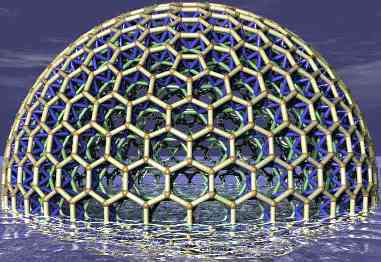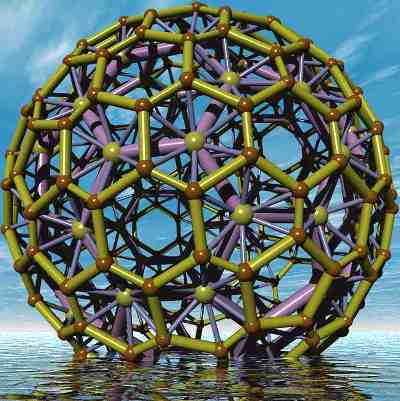
HexDome
Hexagonal Geodesic Domes - Honeycomb Domes
How to build a very big geodesic dome
How will our distant descendants build big geodesic domes?
This is my attempt to answer the questions surrounding the
issue of how best to build a very large geodesic dome.
Thickness
Very large domes necessarily have to be thicker than normal.
I decided to see how thick I could make a dome while
remaining subject to some constraints.
The main constraint I selected was that the weight-bearing
elements should be confined to one layer of the dome. The
other constraints were conventional ones - maximising
strength, minimising material and labour costs.
Here are some of the designs I came up with:
Attaching hexagonal layers together
One of the central technologies employed here is a method of
attaching two hexagonal layers together at right-angles.
As far as I can tell, this approach has not been employed by
previous designers. The following diagram illustrates the
attachment mechanism:

Attaching two hexagonal layers together
A conventional two-layer dome built using this technique
leaves something to be desired.
Three layers
To obtain the desired thickness (and strength) I investigated
constructions that placed reinforcing structural elements on
both sides of the main weight-bearing hexagonal layer.
The resulting designs all wound up having the main weight-
bearing elements surrounded on all sides by stabilising
components.
The approach resulted in a design looking like this:

Triple hexagonal layers
Hidden attractions
I find this design to be beautiful.
However, there are some pleasing aspects to this design that
may not be immediately obvious:
- One is that it resolves an issue afflicting two-layer dome
designs that makes in impractical to employ tension-only
components between the layers - since tightening them
results in stability issues.
The problem arises because the elements between the layers
(which it seems desirable to replace with cables) face no
opposition, and too easily fall together.
Having a third layer resolves this problem - the central
weight bearing layer is now being pulled in both
directions by the cables - and the forces balance.
The interior and exterior faces are connected together with
struts that keep them apart. Pulling them together fails
to make the two layers move together - because of these
struts.
- Another attraction is the relationship between the natural
strut lengths and their functions.
In domes like Fuller's Moscow dome and his Expo '67 dome,
the struts in the triangular layer are actually longer than
those in the hexagonal layer. The theory of hexagonal dome
design strongly suggests that the hexagonal layer should be
where the weight bearing components are concentrated if the
resulting dome is to be suitably light. However the combination
of long struts and light struts does not make structural sense -
struts that are long and light are struts that will
bend and break.
In domes like the ones illustrated here, the proper
relationship is restored: the strong hexagonal elements are
also the ones that are longest - and the weaker supporting
struts are all mercifully short.
- The technique of adding a smaller-mesh hexagonal layer
to an existing one breaks the relationship between strut
length and the size of the faces needed to cover the dome.
Having smaller regions that need covering by fabric should
mean that cheaper fabrics can be employed - and that
construction can be more modular. If necessary the
technique of adding finer layers could be iterated - further
reducing the structural demands placed on any covering
fabric.
Variations
I looked at some variations - to see if I could suck some
material out of the design - while still maintaining most
of its desirable traits.
The first variation I considered involved replacing one
of the layers with a "triaxial weaving"-pattern layer.
Any of the three layers can be replaced in this way -
but it seemed to me that the most attractive one to target
was the interior layer.
A snapshot of the resulting design (from inside):

Triaxial-weave and twin hexagonal layers - from inside
As well as eliminating some of the unnecessary struts, it
seems as though this operation converts many of the squares
in the original design into triangles - and thus may well
represent a substantial structural improvement.
For the sake of comparison, here's the corresponding diagram
for a triple-hexagon dome:

Triple hexagonal layers - from inside
Using the triaxial weave internal layer does indeed appear
to save some nodes and struts while retaining most of the
design's desirable features - and without too many other
deleterious consequences.
The main other variations I considered were:
- Adding tensile-only elements into the dome's "windows";
- Attaching the centres of the main struts to the nearby nodes;
Making attachments to the middle of struts is often
considered to be taboo - but in the case of solid weight-
bearing struts - like those under consideration here - there
is no good reason to avoid doing it.
Tensegrity
As I've mentioned, one of the appealing aspects of this sort
of structure is that it makes using tension-only elements
to stabilise the structure relatively practical.
All the struts between the two exterior layers and
the main weight-bearing interior one could be replaced with
tensile-only elements.
There are two existing domes that illustrate the potential
of this approach - the ASM dome and the original
Climatron. I would classify both of these domes as
Honeycomb domes. Links to photographs of these
are available on this site's
links page.
Insulation
Multi-layer domes like these ones seem to beg for "double-
glazing". That would allow the environment containing the
struts to be controlled independently of the interior and
exterior space - and offer the best insulating layer.
The "triple-hexagon" structure - which presents both
interior and exterior fine-mesh hexagonal layers - seems
particularly well-suited to being insulated.
Disadvantages
The domes illustrated here are big and complicated - with
lots of nodes and struts - which cost money, need assembling
and maintaining - and block out the sky.
Clearly something along these lines is necessary for a
very large dome - but the question arises about at
what size a cheaper and simpler structure can be
employed.
This question will need some empirical work to answer
properly.
However, in my opinion - the answer to the question of at
what size such designs become appropriate is likely to be
"at a smaller scale than you might think".
These designs are extremely strong. Although they
have many elements, their structural strength means that
the elements that are used can be made lighter and cheaper
than would otherwise be possible.
That has positive effects on both construction costs and
material costs.
Gallery
If you are interested in seeing more of these Honeycomb dome, designs
then there are many more images of these in the
Honeycomb dome gallery.
Tim Tyler |
Contact |
http://hexdome.com/
|